Online Detection of Impurities in Corn Deep-Bed Drying Process Utilizing Machine Vision
Abstract
1. Introduction
2. Materials and Methods
2.1. Image Acquisition System
2.2. Image Acquisition and Processing
2.2.1. Image Acquisition
2.2.2. Image Recognition Process
2.2.3. Colour Feature Extraction
2.2.4. Quantitative Evaluation Model of Identification Results
2.2.5. Quantitative Model of Impurity Content
3. Results and Discussion
3.1. Image Preprocessing Results
3.2. Classification and Recognition Results
3.3. Impurity Identification Results
3.4. Quantitative Evaluation of Identification Results
3.5. Field Test Results
4. Conclusions
- A corn deep-bed drying process image acquisition system was developed based on machine vision technology, and the supporting software was also compiled. The system can collect clear corn images in real-time to segment and identify each component of the image and calculate the real-time impurity content in the drying process. The result provides technical support for the accurate online detection of moisture and improvement of flow state during the deep bed drying of corn, and lays a theoretical foundation for adaptive control of the drying process.
- The MSRCR algorithm was used to segment the collected corn image. Each independent closed area of the image was traversed, and the closed areas were classified by setting the HSV colour space parameter threshold to identify broken corncobs, broken bracts, and crushed stones in corn samples. The precision rates of broken corncobs, broken bracts, and broken stones were 83.15%, 84.61%, and 87.62%, respectively. The recall rates of the three impurities were 82.96%, 83.14%, and 87.27%, respectively. The comprehensive evaluation values of the three impurities were 83.05%, 83.87%, and 87.43%, respectively.
- The average error between the online detection results of impurity content using the detection device and the manual detection results in the corn deep-bed drying process was 0.08%, which indicated that the system can accurately analyse the impurity content in the corn drying process. Therefore, the system can be used as an effective method for the online detection of impurities in the corn deep-bed drying process.
Author Contributions
Funding
Data Availability Statement
Acknowledgments
Conflicts of Interest
References
- Aut Huang, H.; Yang, M.; Huang, G. Construction and evaluation of mechanized production engineering mode for major food crops. Trans. Chin. Soc. Agric. Eng. 2013, 29, 53–61. [Google Scholar] [CrossRef]
- Wang, H. When there is food, we often think of no food. J. Chin. People’s Political Consult. Conf. 2022, 3, 1. [Google Scholar] [CrossRef]
- Zhao, X.; Tao, Y.; Cao, B. Evaluation and analysis of grain loss after production in china. J. Arid Land Resour. Environ. 2022, 36, 1–7. [Google Scholar] [CrossRef]
- Li, C.; Fang, Z.; Zhong, J.; Li, B.; Li, C. Evaluating the dynamic characteristics and energetic performance of a paddy multistage counter-flow dryer. Biosyst. Eng. 2022, 221, 208–223. [Google Scholar] [CrossRef]
- Chen, J.; Lian, Y.; Li, Y. Real-time grain impurity sensing for rice combine harvesters using image processing and decision-tree algorithm. Comput. Electron. Agric. 2020, 175, 105591. [Google Scholar] [CrossRef]
- Wu, K.; Zhang, M.; Wang, G.; Chen, X.; Wu, J. A Continuous Single-Layer Discrete Tiling System for Online Detection of Corn Impurities and Breakage Rates. Agriculture 2022, 12, 948. [Google Scholar] [CrossRef]
- Bomoi, M.I.; Nawi, N.M.; Abd Aziz, S.; Mohd Kassim, M.S. Sensing Technologies for Measuring Grain Loss during Harvest in Paddy Field: A Review. AgriEngineering 2022, 4, 292–310. [Google Scholar] [CrossRef]
- Li, T.; Li, C.; Li, C.; Xu, F.; Fang, Z. Porosity of flowing rice layer: Experiments and numerical simulation. Biosyst. Eng. 2019, 179, 1–12. [Google Scholar] [CrossRef]
- Wang, G.; Wu, W.; Fu, D.; Xu, W.; Xu, Y.; Zhang, Y. Energy and Exergy Analyses of Rice Drying in a Novel Electric Stationary Bed Grain-Drying System with Internal Circulation of the Drying Medium. Foods 2022, 11, 101. [Google Scholar] [CrossRef]
- State Administration of Grain. GB/T 5494-2008; Inspection of Impurities and Imperfect Grains in Grains and Oils. Standards Press: Beijing, China, 2009.
- Wang, P.; Meng, Z.; Luo, C.; Mei, H. Path Recognition for Agricultural Robot Vision Navigation under Weed Environment. In Computer and Computing Technologies in Agriculture VII. CCTA 2013. IFIP Advances in Information and Communication Technology; Li, D., Chen, Y., Eds.; Springer: Berlin/Heidelberg, Germany, 2014; p. 419. [Google Scholar] [CrossRef]
- Jiang, H.; Zhang, C.; Qiao, Y.; Zhang, Z.; Zhang, W.; Song, C. CNN feature based graph convolutional network for weed and crop recognition in smart farming. Comput. Electron. Agric. 2020, 174, 105450. [Google Scholar] [CrossRef]
- Nagar, H.; Sharma, R.S. A Comprehensive Survey on Pest Detection Techniques using Image Processing. In Proceedings of the 4th International Conference on Intelligent Computing and Control Systems (ICICCS), Madurai, India, 25–26 June 2020; pp. 43–48. [Google Scholar] [CrossRef]
- Tang, T.; Zhang, M.; Mujumdar, A.S. Intelligent detection for fresh-cut fruit and vegetable processing: Imaging technology. Compr. Rev. Food Sci. Food Saf. 2022, 21, 5171–5198. [Google Scholar] [CrossRef] [PubMed]
- Wei, X.; Jia, K.; Lan, J.; Li, Y.; Zeng, Y.; Wang, C. Automatic method of fruit object extraction under complex agricultural background for vision system of fruit picking robot. Optik 2014, 125, 5684–5689. [Google Scholar] [CrossRef]
- Rezaei, S.; Behroozi-Khazaei, N.; Darvishi, H. Microwave power adjusting during potato slice drying process using machine vision. Comput. Electron. Agric. 2019, 160, 40–50. [Google Scholar] [CrossRef]
- Khazaei, N.B.; Tavakoli, T.; Ghassemian, H.; Khoshtaghaza, M.H.; Banakar, A. Applied machine vision and artificial neural network for modeling and controlling of the grape drying process. Comput. Electron. Agric. 2013, 98, 205–213. [Google Scholar] [CrossRef]
- Li, X.; Zhang, Y.; Xie, Y.; Yu, X.; Zhu, G.; Gao, Z. Effects of relative humidity on the exterior quality of shiitake mushrooms (Lentinus edodes) during hot air drying. Trans. Chin. Soc. Agric. Eng. 2020, 36, 281–291. [Google Scholar] [CrossRef]
- Wang, G.; Zhu, C.; Wang, Y.; Xu, P.; Li, Z.; Yang, W.; Miao, T.; Liu, H.; Xu, D.; Zhang, W.; et al. A Method for Determination of Grain. Impurities. Patent No. CN113447502A, 28 September 2021. [Google Scholar]
- Liang, N.; Sun, S.; Yu, J.; Taha, M.F.; He, Y.; Qiu, Z. Novel segmentation method and measurement system for various grains with complex touching. Comput. Electron. Agric. 2022, 202, 107351. [Google Scholar] [CrossRef]
- Chen, J.; Gu, Y.; Lian, Y.; Han, M. Online recognition method of impurities and broken paddy grains based on machine vision. Trans. Chin. Soc. Agric. Eng. 2018, 34, 187–194. [Google Scholar] [CrossRef]
- Luo, H.; Li, C.; Zhang, Y. Design and experimental study of 5HP-25 type grain dryer. Trans. Chin. Soc. Agric. Eng. 2021, 37, 279–289. [Google Scholar] [CrossRef]
- Jiang, B.; Woodell, G.A.; Jobson, D.J. Novel multi-scale retinex with color restoration on graphics processing unit. J. Real-Time Image Process. 2015, 10, 239–253. [Google Scholar] [CrossRef]
- Jiao, S.; Li, X.; Lu, X. An Improved Ostu Method for Image Segmentation. In Proceedings of the 2006 8th international Con-ference on Signal Processing, Guilin, China, 16–20 November 2006; pp. 164–166. [Google Scholar] [CrossRef]
- Li, C.; Chen, Y.; Zhang, X.; Mozafari, G.; Fang, Z.; Cao, Y.; Li, C. Exergy analysis and optimisation of an industrial-scale circulation counter-flow paddy drying process. Energy 2022, 251, 123901. [Google Scholar] [CrossRef]
- Xu, X.; Zhao, T.; Ma, J.; Song, Q.; Wei, Q.; Sun, W. Application of Two-Stage Variable Temperature Drying in Hot Air-Drying of Paddy Rice. Foods 2022, 11, 888. [Google Scholar] [CrossRef] [PubMed]
- Zhang, Y.; Wu, W.; Wang, G. Separation of corn seeds images based on threshold changed gradully. Trans. CSAE 2011, 27, 200–204. [Google Scholar] [CrossRef]
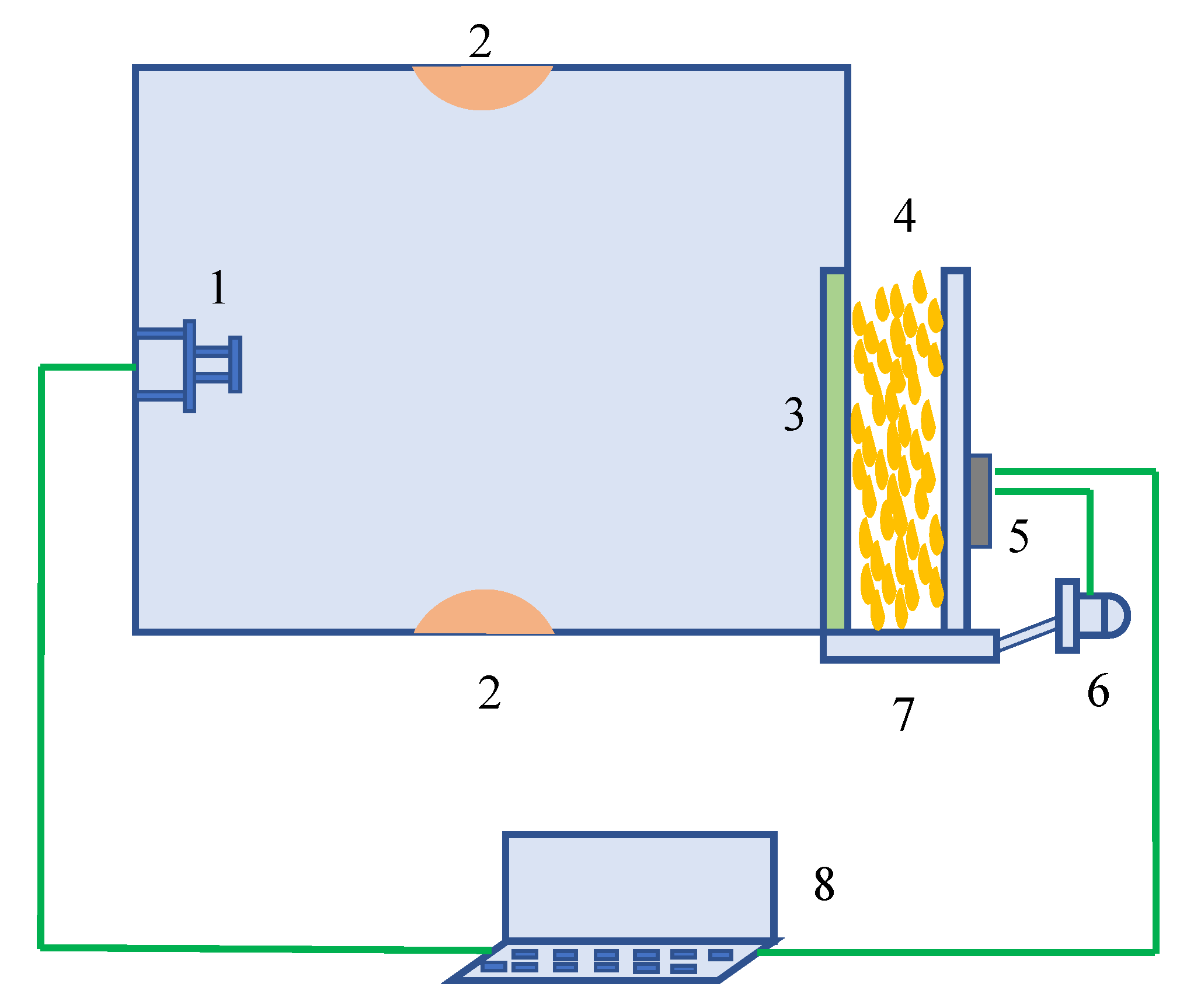
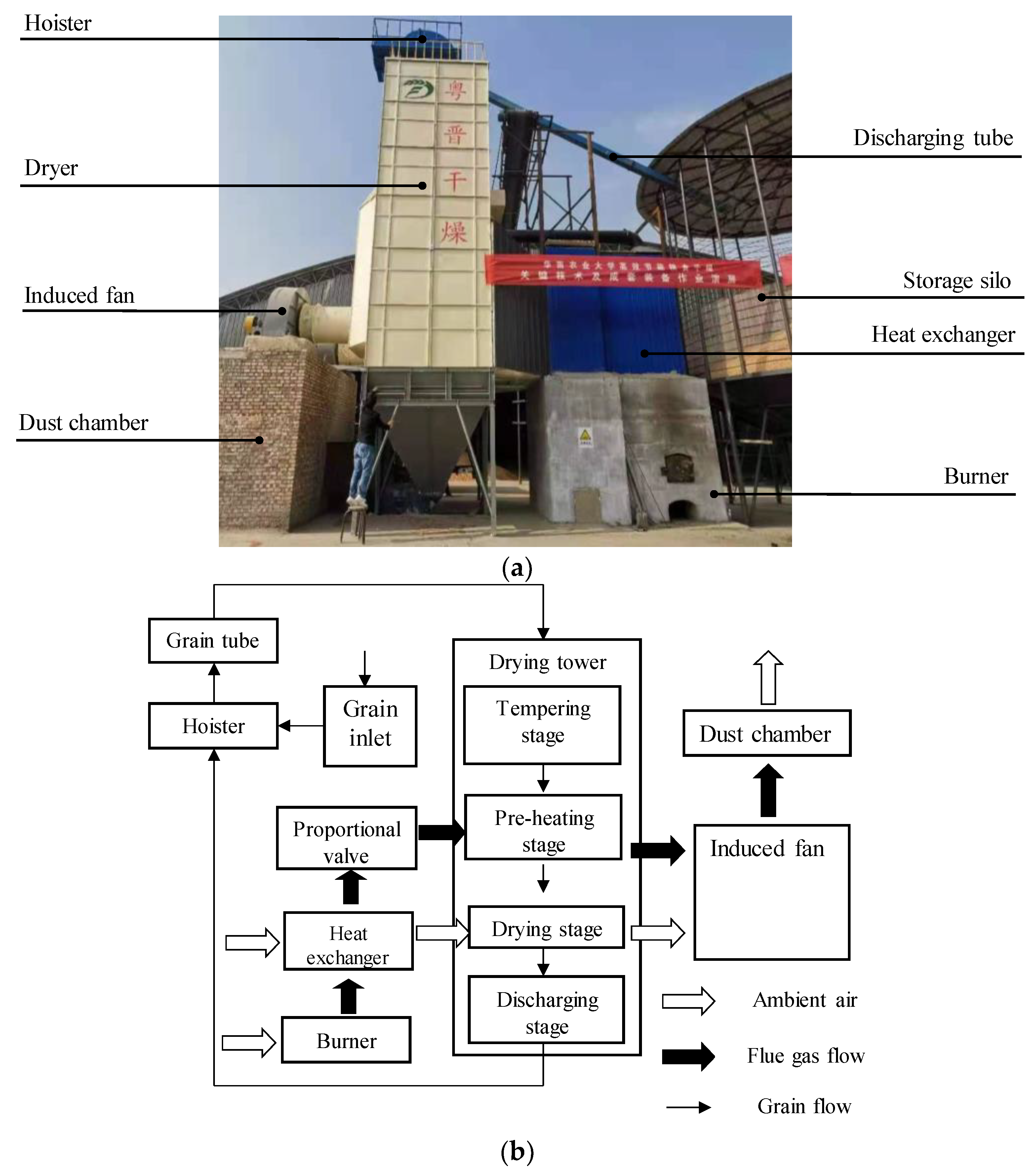
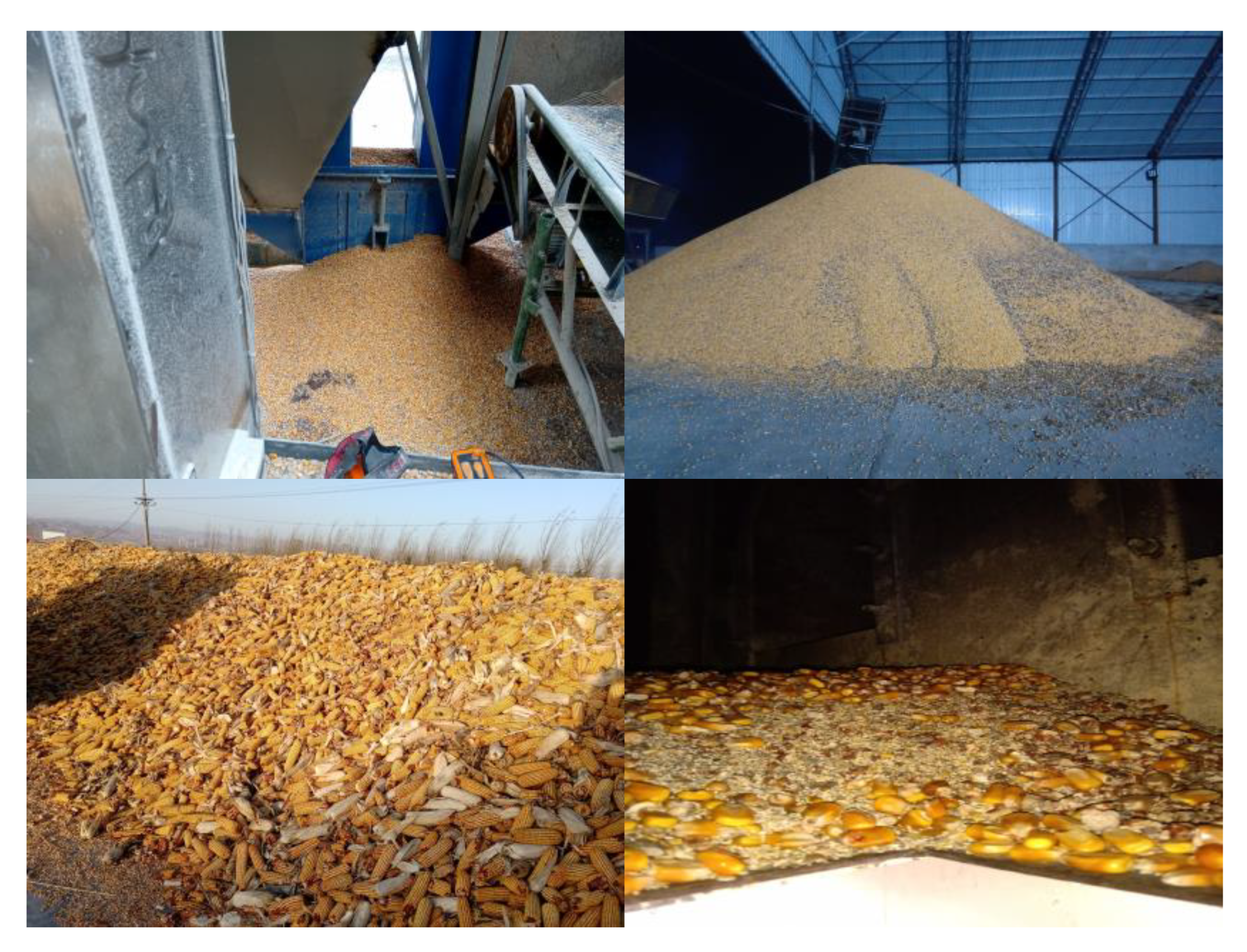
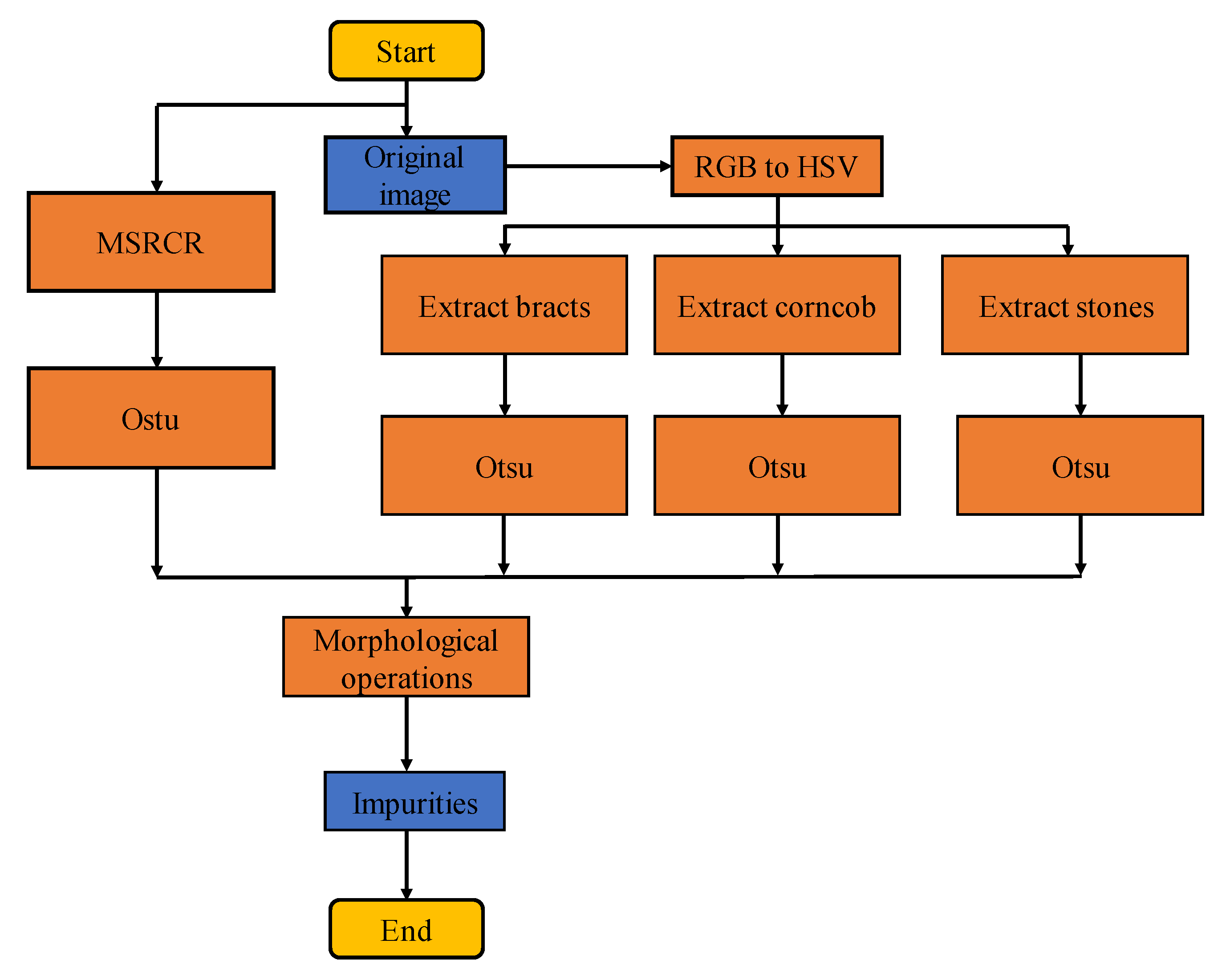
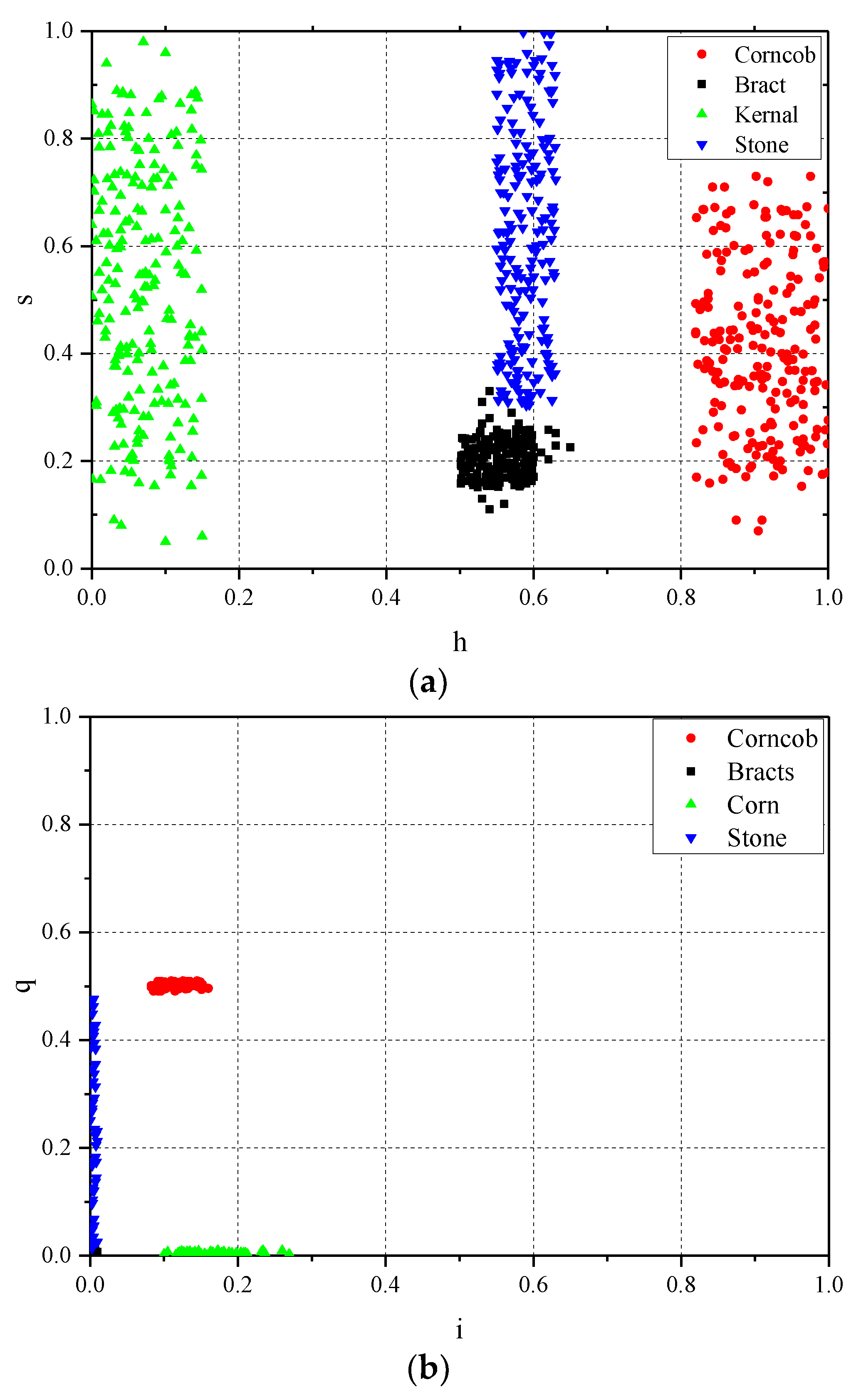
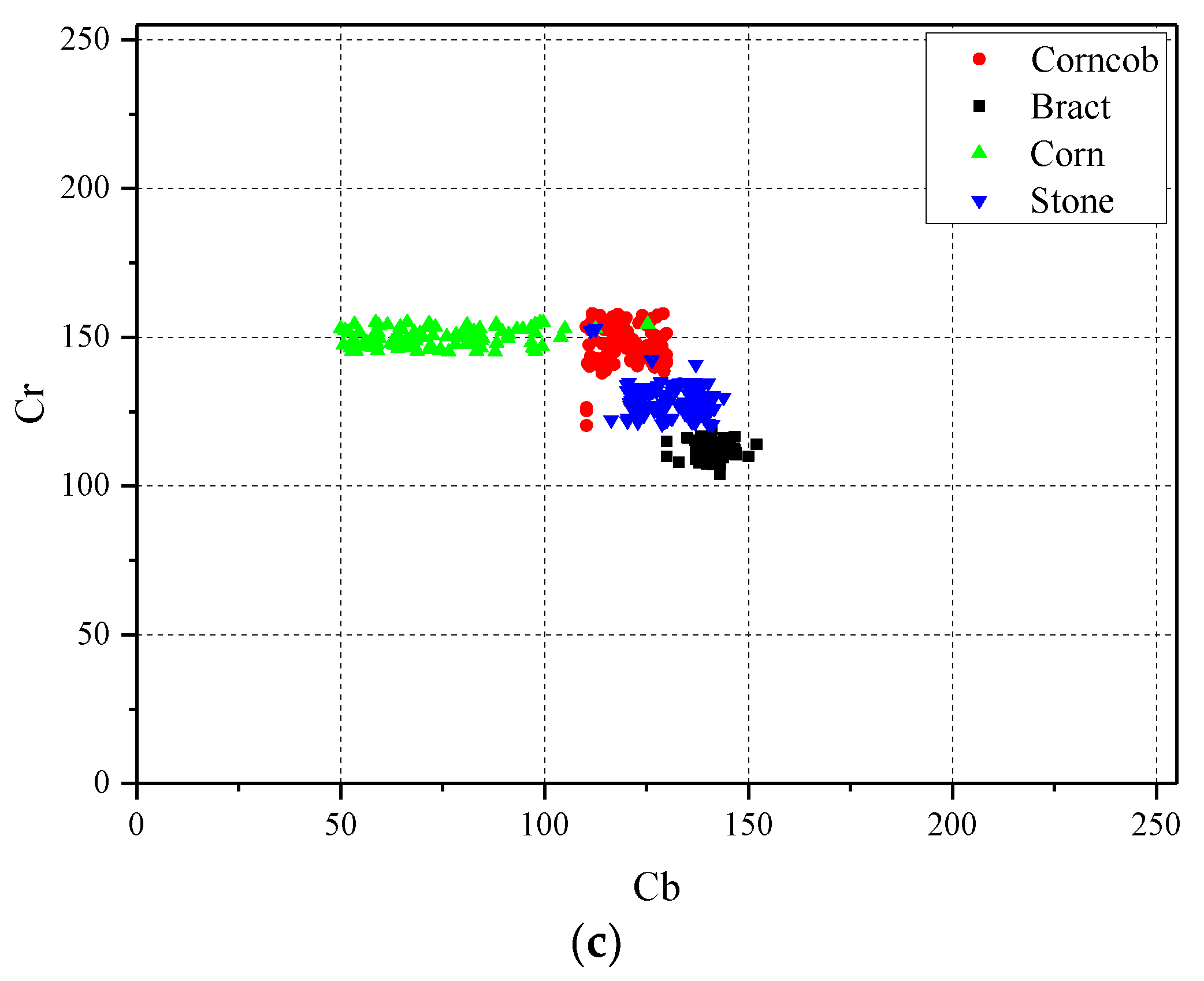
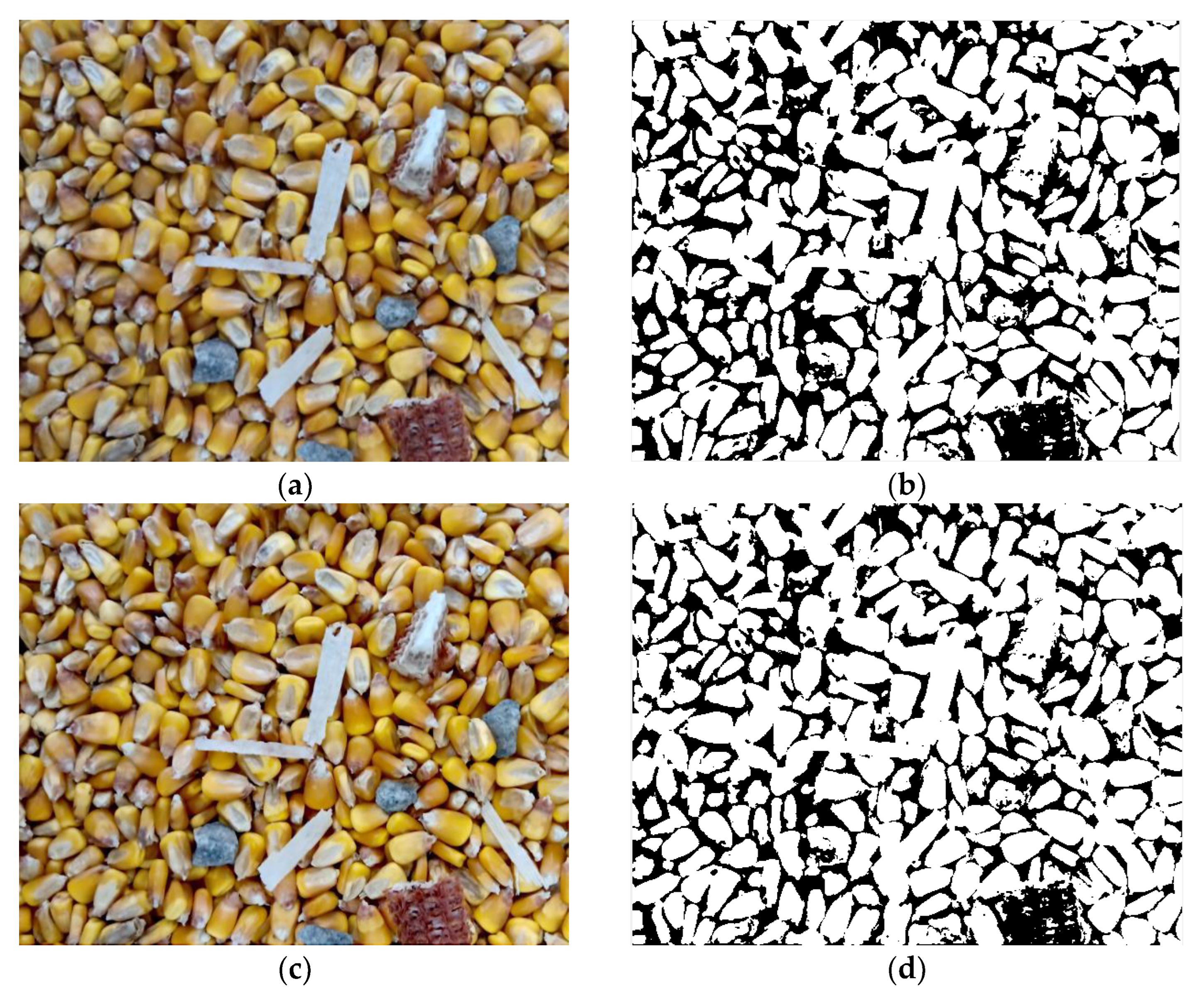


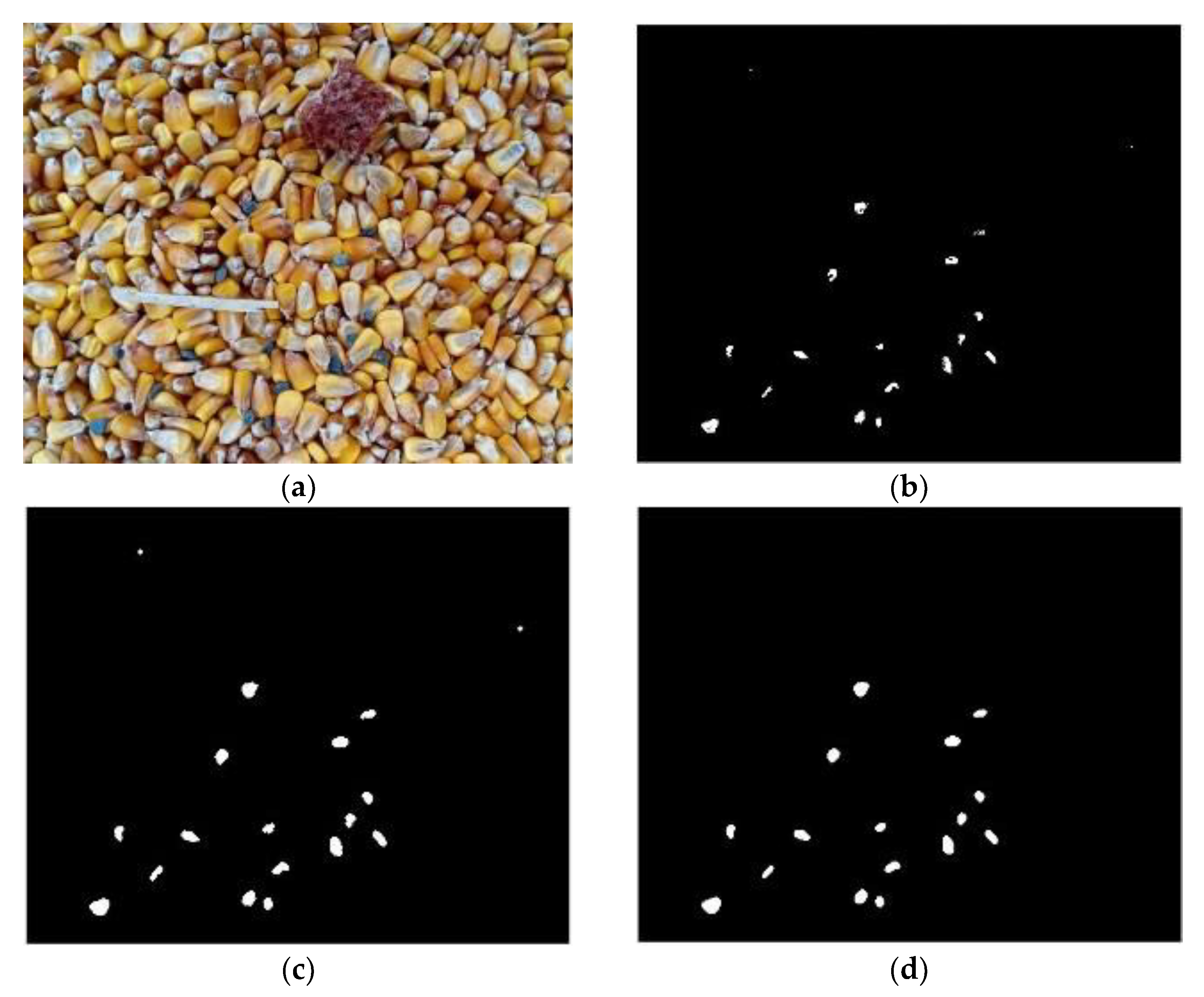
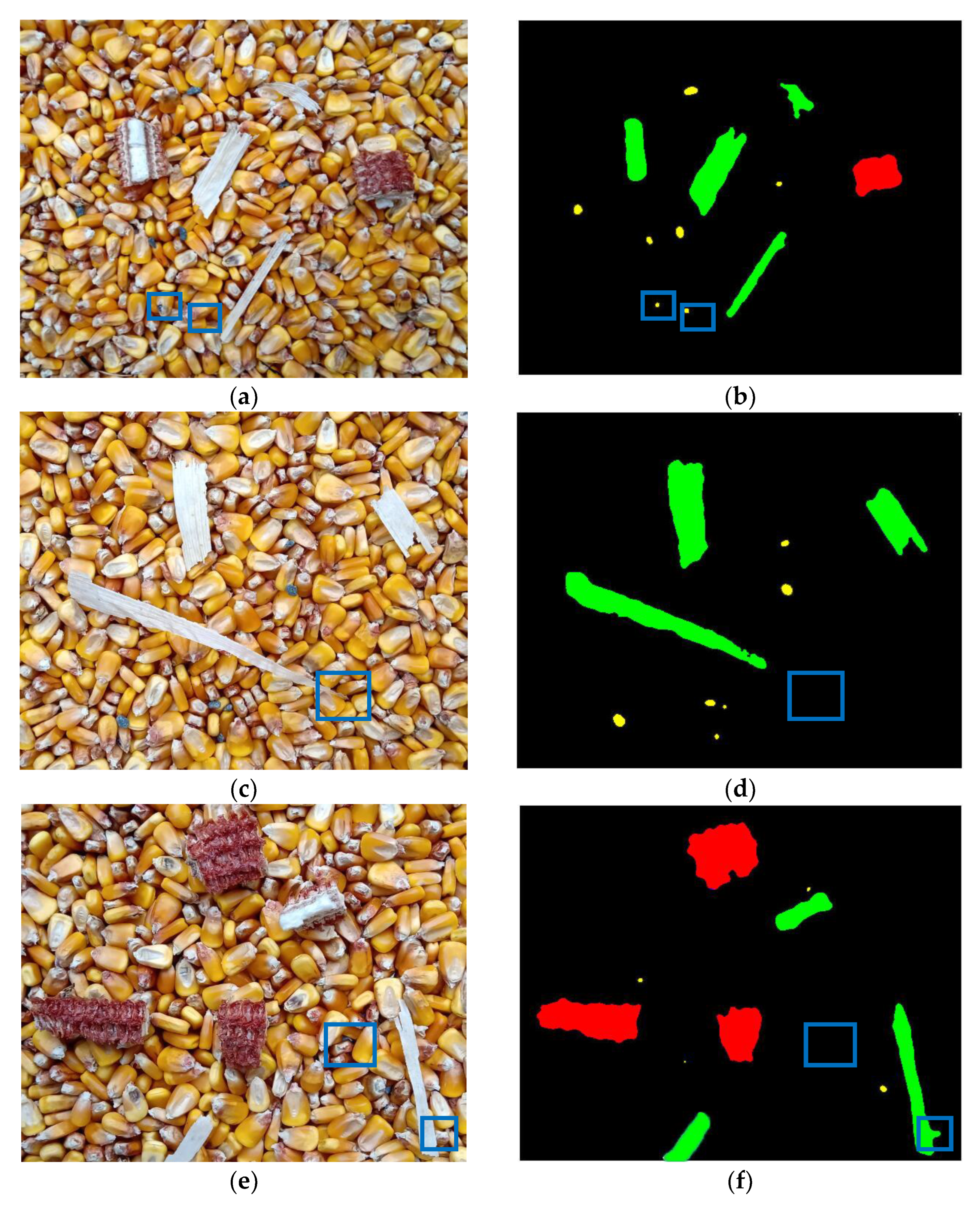

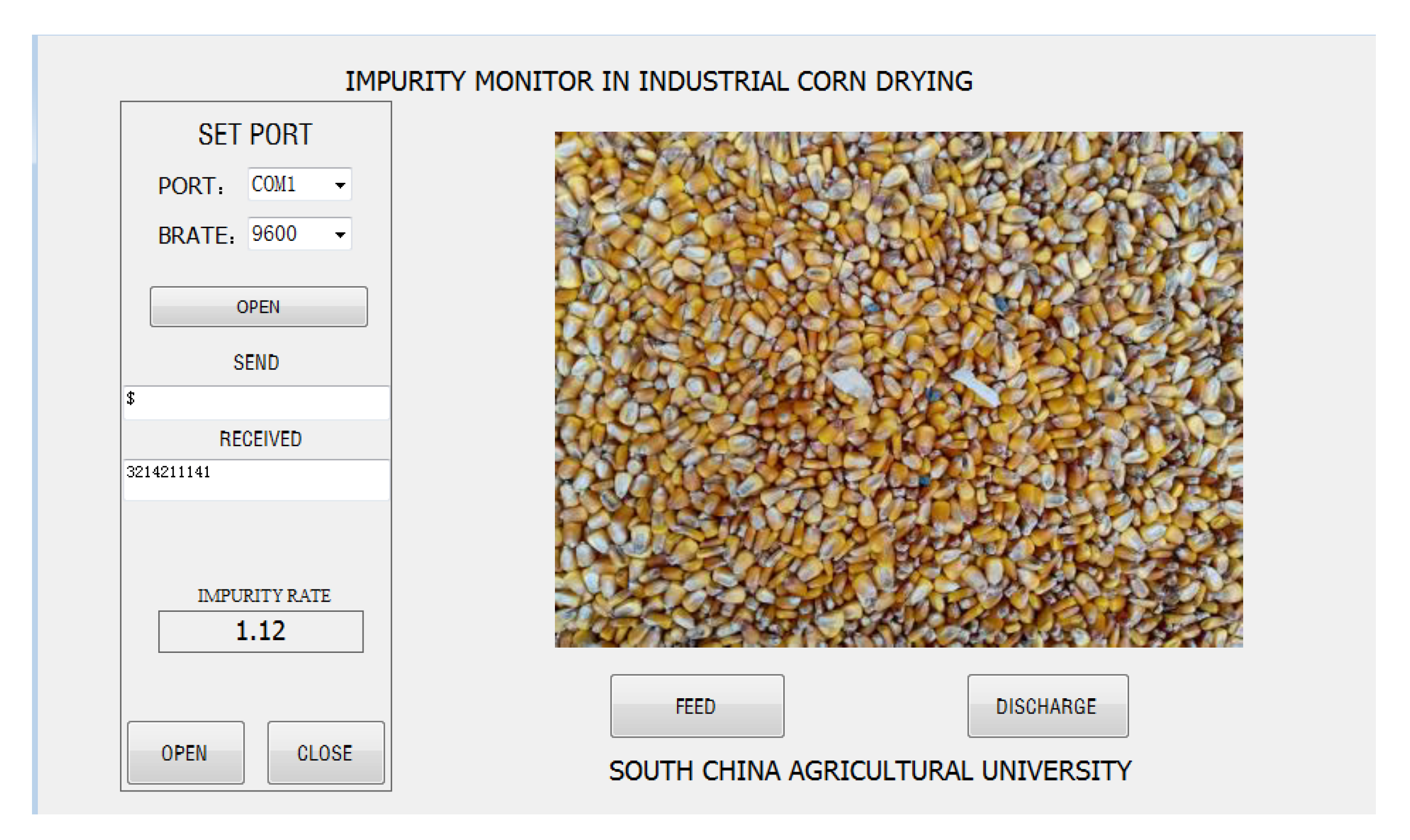
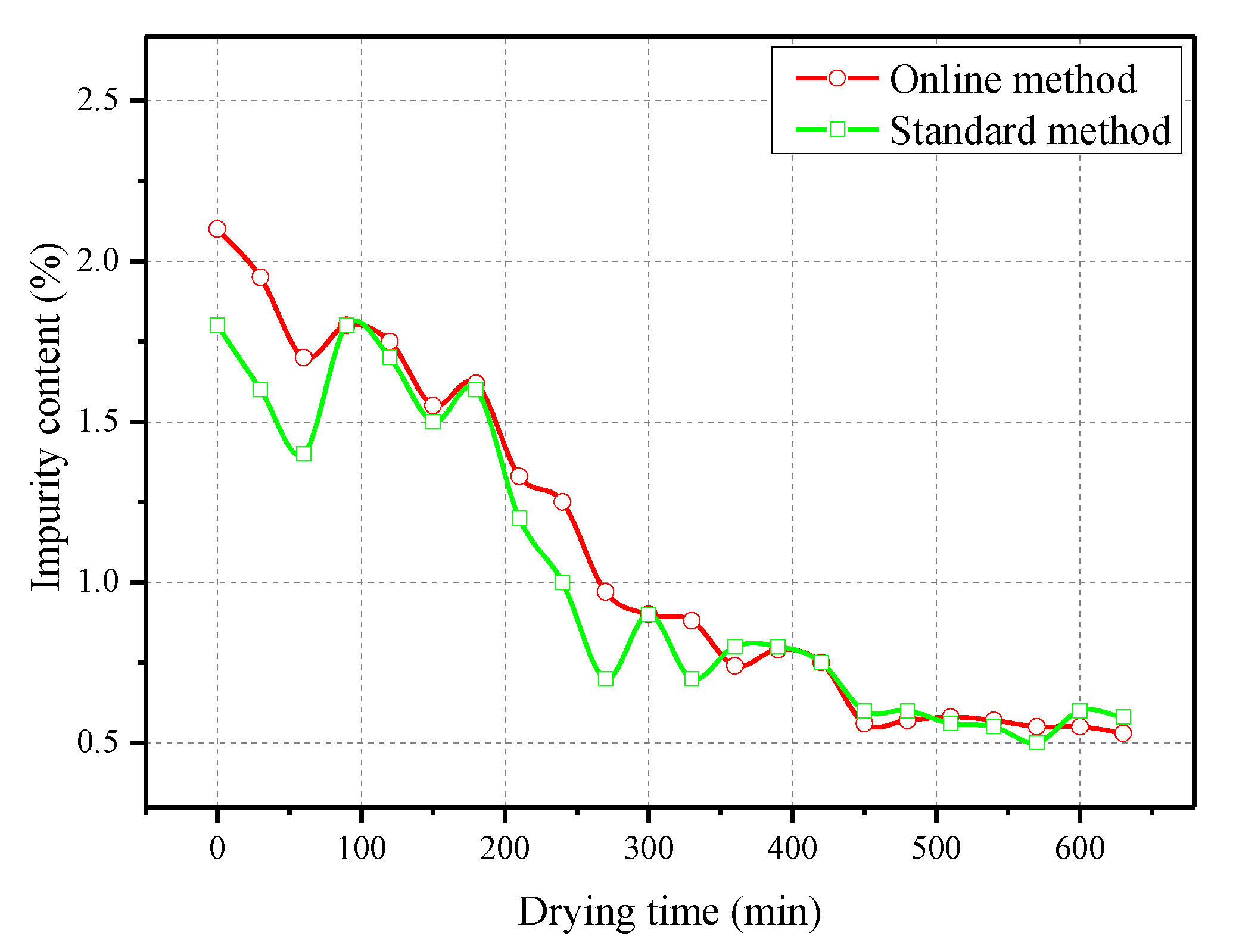
| Category of Impurities | Pa/% | Ra/% | F1/% |
|---|---|---|---|
| Broken corncob | 83.15 | 82.96 | 83.05 |
| Broken bracts | 84.61 | 83.14 | 83.87 |
| Crushed stones | 87.62 | 87.24 | 87.43 |
Publisher’s Note: MDPI stays neutral with regard to jurisdictional claims in published maps and institutional affiliations. |
© 2022 by the authors. Licensee MDPI, Basel, Switzerland. This article is an open access article distributed under the terms and conditions of the Creative Commons Attribution (CC BY) license (https://creativecommons.org/licenses/by/4.0/).
Share and Cite
Li, T.; Tong, J.; Liu, M.; Yao, M.; Xiao, Z.; Li, C. Online Detection of Impurities in Corn Deep-Bed Drying Process Utilizing Machine Vision. Foods 2022, 11, 4009. https://doi.org/10.3390/foods11244009
Li T, Tong J, Liu M, Yao M, Xiao Z, Li C. Online Detection of Impurities in Corn Deep-Bed Drying Process Utilizing Machine Vision. Foods. 2022; 11(24):4009. https://doi.org/10.3390/foods11244009
Chicago/Turabian StyleLi, Tao, Jinjie Tong, Muhua Liu, Mingyin Yao, Zhifeng Xiao, and Chengjie Li. 2022. "Online Detection of Impurities in Corn Deep-Bed Drying Process Utilizing Machine Vision" Foods 11, no. 24: 4009. https://doi.org/10.3390/foods11244009
APA StyleLi, T., Tong, J., Liu, M., Yao, M., Xiao, Z., & Li, C. (2022). Online Detection of Impurities in Corn Deep-Bed Drying Process Utilizing Machine Vision. Foods, 11(24), 4009. https://doi.org/10.3390/foods11244009




